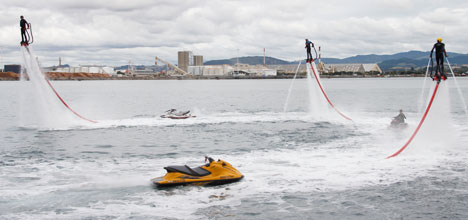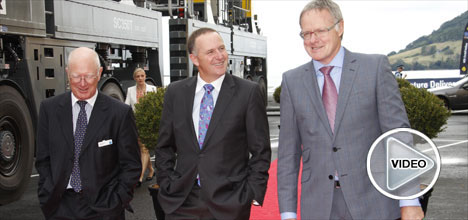The $30 million northern extension to the Port of Tauranga's Sulphur Point Wharf is officially open.
The project, including a 170metre wharf extension, installation of a Super-Port Panamax ganrty crane and new straddle carriers, was officially opened by Prime Minister John Key today.
Port chairman John Parker, Prime Minister John Key and Port CEO Mark Cairns.
 The new crane at the Port of Tauranga.
The new crane at the Port of Tauranga.
It has expanded the Port's container wharf length by nearly a third bringing it into what port company CEO Mark Cairns says is the 'next phase of Port of Tauranga's growth”.
'We're now in an excellent position to handle new services and the growing trend to more frequent visits from larger ships,” says port company CEO Mark Cairns.
'It's a huge step-up in the capability of New Zealand s port infrastructure.”
The capital expenditure programme also includes the installation and commissioning of a new Liebherr Super-Post Panamax ship-to-shore twinlift gantry crane, bringing the number of the Terminal's container cranes to six.
The port has also purchased six new straddle carriers to transport containers to and from the cranes.
In the last two years the Port has increased its ground slot capacity by 30 per cent and refrigerated container outlets by 60 per cent. It has also constructed a new rail siding and reconfigured the existing area to allow up to four trains to be loaded and unloaded at once.
Mark says the investment programme in the terminal is the largest expenditure since the container terminal opened two decades ago.
The onshore additions will be complemented by major dredging works scheduled to begin later this year, which will widen and deepen Tauranga Harbour shipping channels to accommodate larger vessels.
'Our ability to cater for larger ships will not only benefit the Bay of Plenty, but also the broader national economy,” says Mark.
'These investments are vital to ensure New Zealand's exporters can remain competitive globally. Port of Tauranga will continue to invest to ensure we lead New Zealand's port infrastructure developments into the future.”
The three year capital investment programme for the Tauranga Container Terminal will total $170 million.
Adding 170 metres to the existing 600 metres of Sulphur Point wharf allows the container wharf to handle three large ships simultaneously.
When the original wharf was built 20 years ago, container ships visiting Tauranga averaged 180metres in length. The average length of visiting ships is today around 230metres.
 The ribbon is cut at the official opening of the Port of Tauranga's new wharf.
The ribbon is cut at the official opening of the Port of Tauranga's new wharf.
 Flyboard X performing at the opening of the Port's new wharf extension.
Flyboard X performing at the opening of the Port's new wharf extension.
Prime Minister John Key says the growth efficiencies that will be achieved through the wharf extensions, the new cranes, the straddle carriers and the dredging programme make Tauranga the port of the future.
The future of shipping is going to see much larger ships, with more pressing demands on how quickly they can be loaded and unloaded and how efficient New Zealand's ports can be.
The Prime Minister says the benefits will be felt by every exporter and importer, and contrasted the Port of Tauranga's efficiencies with the cost of getting a container into Australia.
'I'll give you a clue, the problem isn't at the New Zealand end,” says John.
Port efficiency for New Zealand is critically important, says John.
'In the end all those costs are borne by the consumers that buy our products. And if we have inefficiencies in our ports, then we have higher prices and then other people can take our markets away from us.
'I think what's happening here is really important.”
Contractor for the wharf extension is Tauranga-based HEB Construction. Construction involved driving 353 piles, the dredging of around 50,000 cubic metres of sand and silt and the placement of 30,000 cubic metres of rock under the wharf deck.
The new wharf's design is influenced by lessons learned following the Christchurch earthquakes, which damaged infrastructure at Lyttelton Port Company.
Port of Tauranga will now be able to offer shipping lines the ability to handle larger ships, a greater choice of berth windows, flexibility to make booking changes, and greater crane intensity to load/unload ships more quickly.
The new Liebherr ship-to-shore gantry crane is a Super-Post Panamax Model, meaning it can service vessels 18 containers wide. It is twin-lift capable, so it can lift two 20foot containers (TEUs) at once.
The Tauranga Container Terminal now has six gantry cranes, two of which are the Super-Post Panamax model.
A seventh crane has been ordered for delivery in December this year and will be commissioned in March 2014. Six new twinlift-capable straddle carriers have recently been commissioned, increasing the terminal's total fleet to 36.
Three of the new straddle carriers have been bought from Liebherr, the first to be used in the southern hemisphere.
An additional 4.1 hectares of land has been sealed at the Tauranga Container Terminal in the last two years. Ground slot capacity has increased from 3760 to 4900 slots.
The refrigerated (reefer) container capacity has been increased from 1020 to 1620 outlets.
An additional three hectares of land is available outside the port boundaries for empty container storage.
Modifications to the rail sidings now allow four trains to be loaded and unloaded at once, making freight transfers to and from Auckland faster and more efficient.
The number of trains between the Tauranga Container Terminal and the inland port, MetroPort in Auckland is currently five per day with capacity to at least double. Five trains equates to 530 TEUs each way per day.
 One of the new straddle carriers at the Port of Tauranga.
One of the new straddle carriers at the Port of Tauranga.
Dredging project
The dredging project will widen and deepen the shipping channel in the harbour from 12.9metres to 16.0metres depth at low water and in the entrance from 14.1metres to 17.3metres at low water.
Ships of up to 347metres in length and 14.5metres draught will ultimately be able to be accommodated in Tauranga Harbour.
The first stage of dredging is estimated to cost $40million to $50 million and will give access to container ships with a capacity of 5000 to 6000 TEUs.
The second stage will accommodate ships of 8200 TEUs, future-proofing the port for the next 15 to 20 years. Dredging will also allow larger bulk cargo and cruise ships to visit the Port of Tauranga.
Port of Tauranga is New Zealand s largest port by total volume, container throughput and land area.
It operates wharves at Sulphur Point and Mount Maunganui in Tauranga, as well as MetroPort, a rail-linked inland port in South Auckland.
The Port of Tauranga Group includes Tapper Transport, Quality Marshalling, Northport, MetroPack , MetroBox and a minority shareholding in Cubic Transport Services.
Tauranga Container Terminal
The terminal handled more than 850,000 TEUs (twenty foot equivalent units) last year. In the six months to December 2012, containers handled increased 25.5 per cent compared to the same period the previous year.
Trans-shipped cargo volumes (cargo changing ships at Port of Tauranga wharves) grew by 48 per cent in the second half of 2012, underscoring the Port's position as the national hub port.
The Tauranga Container Terminal occupies 47 hectares at Sulphur Point, with 25 hectares of adjacent land available for future expansion.

 NZ sailor Grant Dalton attends the Port of Tauranga new wharf opening.
NZ sailor Grant Dalton attends the Port of Tauranga new wharf opening.



2 comments
Appropriate
Posted on 04-04-2013 16:19 | By penguin
Notice that the carpet is red along with the ribbon that the 'blue'national PM cut? All is not lost, people!
Great stuff
Posted on 04-04-2013 16:41 | By YadaYada
The Port of Tauranga Board and staff really are shining lights and a great example of doing things right.
Leave a Comment
You must be logged in to make a comment.